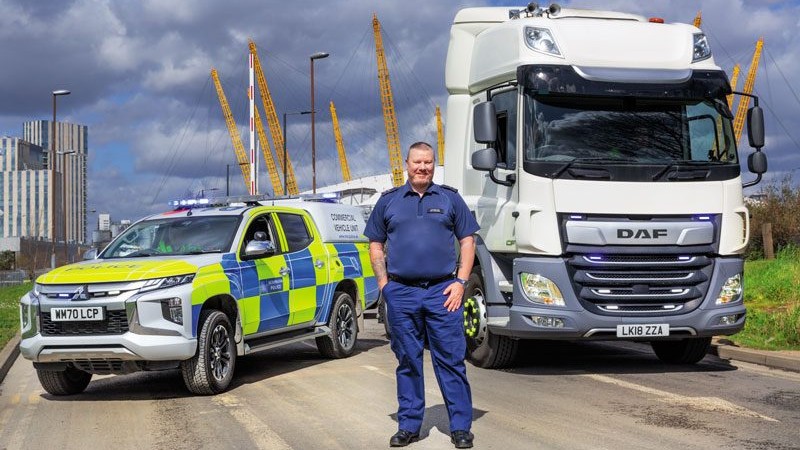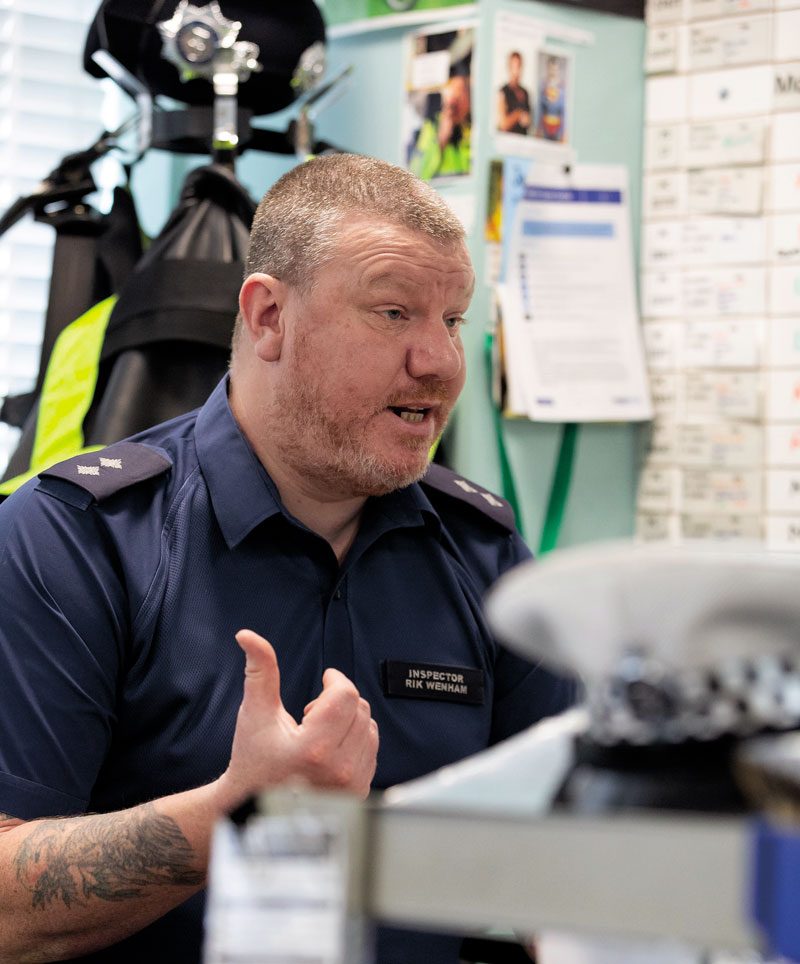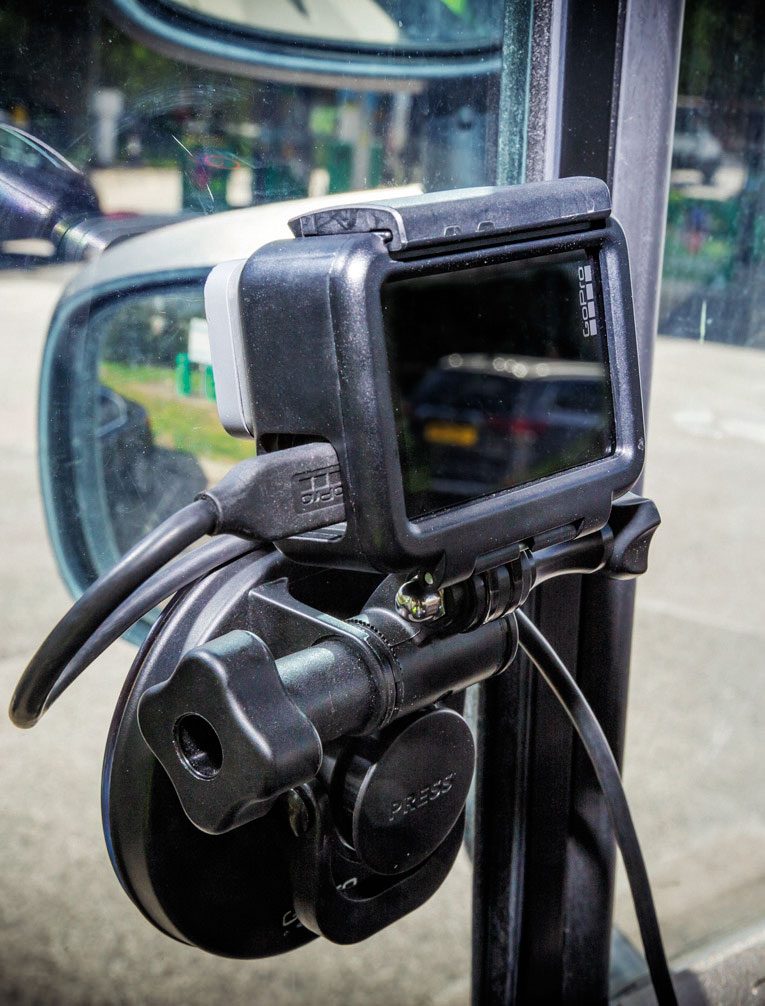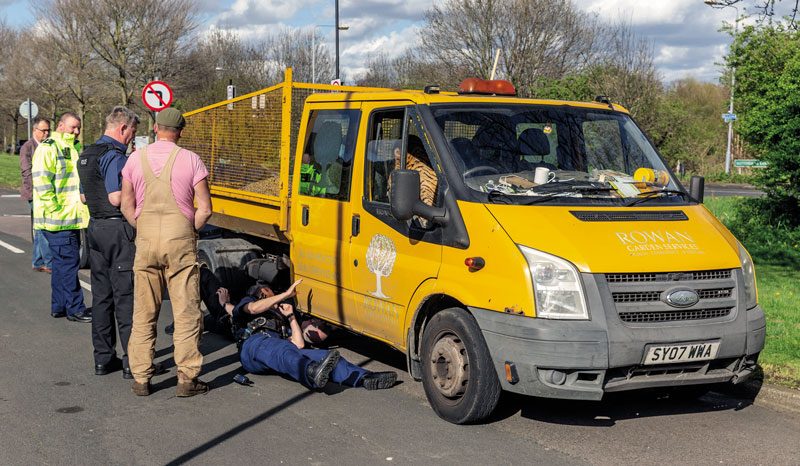
Will Shiers spends the day with London’s Metropolitan Police Force, and its unmarked DAF CF truck.
Inspector Richard Wenham heads up London’s Metropolitan Police Commercial Vehicle Unit and reckons he’s in his dream job.
“As a child, I loved watching CHiPs and Smokey and the Bandit, so I either wanted to be a motorbike police officer or a lorry driver. Little did I know I’d find a job where I could combine both of these passions,” he tells me when I spend a day shadowing him and some of his team of 60 officers.
But today, he won’t be using either his motorbike or heavy-goods vehicle licence. Instead, he and I will be travelling around the M25, London’s orbital motorway, in an unmarked BMW 5-Series, following a relatively anonymous DAF CF450. But while it looks like just another white CF, there’s far more to this truck than meets the eye. This is the Met’s latest weapon in its fight against distracted drivers.
Police use the truck for creeping up on unsuspecting drivers who are doing things they shouldn’t be doing behind the wheel, while a pair of GoPros in the windows record their wrongdoing as evidence. Although the most common misdemeanour is using a mobile phone while driving, Inspector Wenham and his team have recorded some incredible things over the years.
“We’ve caught truck drivers eating a meal on the steering wheel with a knife and fork, watching a football match on an iPad and using a portable kettle to make a cup of tea while driving along,” he says.


While the police still find the occasional truck driver using a phone, these days car drivers are increasingly getting caught. And when they are, they receive six penalty points and a £200 ($385) fine. To put this into perspective, once you reach 12 points, you face a driving ban of at least six months. “They think they are invincible and invisible because they’re holding it on their thigh and tapping away under the window line,” Inspector Wenham tells us.
The truck is shared between the unit’s four London sites, and is on the road for five days a week. Today it’s been driven by PC Martin Davis and will patrol the southern section of the M25.
Although the truck has blue lights on the front and rear and can act independently, it’s generally supported by an unmarked police car. Hence us following in the BMW.
The best condition for catching phone users is slow-moving rush-hour traffic. The truck will sit in the middle lane, allowing it to film motorists on either side. “It’s like shooting fish in a barrel,” says PC Davis.
But today, the M25 is running freely. As we follow the DAF, I ask Inspector Wenham why he thinks it’s important to crack down on phone use. He tells me that “a fatal four cluster of offences” are responsible for most road fatalities: speed, seatbelts, drink/drugs and phones. And increasingly, it’s the latter. He has seen some horrific accidents caused by drivers texting at the wheel and recalls one particular incident from a couple of years ago. “The driver of an empty 12-tonner went into the back of a stationary loaded 32-tonner at 56mph (90kph). His tachograph went from 56mph to zero in 0.3 seconds. We know he was texting as it was recorded in his in-cab camera. He hit it so hard that it broke the tipper’s rear axles. He was trapped for an hour, and in the end, the air ambulance paramedics had to cut off his legs at the knees to prevent him from bleeding to death.
Suddenly Inspector Wenham puts on the blues and twos and floors the BMW. He’s spotted something up ahead that needs dealing attention. A car is being driven at full speed up the motorway hard shoulder. It doesn’t take long to catch up and pull the elderly driver over. It transpires that he’s simply confused, momentarily thinking he was on a smart motorway, so he is sent on his way with a warning.


The ironically named “smart” motorway is Britain’s latest attempt to combat congestion on the cheap by turning many motorway hard shoulders into live lanes. There are emergency refuge areas, but on the M25, they can be up to 2.5km apart. Break down between these areas, and you run the very real risk of being hit from behind by 44 tonnes. Several deaths have occurred as a result. “Don’t even get me started on smart motorways,” says Inspector Wenham, “I think the whole concept is insane.”
It doesn’t take long to catch up with the DAF, which is in the middle lane now, slowly overtaking a row of trucks. Although it is currently limited to 90kph, it will be undergoing work to increase the speed. Inspector Wenham explains that this will allow it to catch up with some foreign trucks that have had their speed limiters disabled.
Suddenly, the radio springs to life as PC Davis in the DAF wants to pull over an 18-tonne scaffolding truck. As he was approaching it, he was conscious that it was swerving, and it came as little surprise to him to discover that the driver was indeed texting behind the wheel.
Initially, after having been pulled over, the driver refuses to accept that he was using his phone, claiming to have been playing around with his AirPods instead. But when he’s shown the footage, he accepts that he’s been caught bang to rights. Incredibly, he was already on nine points, so this incident will likely result in a driving ban.
“We’re in a world where everyone has a phone, and to many, it’s the most important thing,” says PC Davis. “Sadly, a lot of people are prepared to use them while driving, and that’s what this guy did with his 18-tonne truck.”
Our journey back to Catford police station takes us through southeast London’s suburbs. While we’re driving down one street, Inspector Wenham recalls a tragic incident taking place at that spot. A 32-tonne tipper was slowly driving along when suddenly a passing pedestrian found himself under the truck’s rear wheels. As is often the case, the incident was no fault of the driver. Camera footage from the vehicle travelling behind revealed that the elderly pedestrian dived towards the loaded tipper, intentionally placing his head in the path of the rear bogie. He tells us suicide is an increasing issue for lorry drivers, who often struggle to deal with the aftermath. Whereas train drivers will get weeks or even months off work following a suicide, truck drivers are expected to go home and just get on with it. “It’s a hole that we have identified and have started to tackle,” he tells me. “Because of the industry we’re in and the demographics of people working in it, many won’t want to talk to a counsellor, even on the phone. We signpost to a charity called Shout. And you can have a text conversation with a counsellor, which is completely anonymous.”

We are about 8km from the police station, when suddenly PC Davis in the DAF radios to say he’s just been passed by a Ford Transit whose driver is using his phone behind the wheel. As the driver passes us, he’s still doing it, his phone gripped by both hands on top of the steering wheel.
Inspector Wenham spins the BMW around and immediately gives chase, stopping the battered old yellow tipper a few hundred metres down the road. Before he even gets out of the car, he clocks a shovel hanging out of the back of the load bed and a missing rear mudguard. So that’s potentially six points for the phone, three for the insecure load, and another three for the missing spray suppression. A closer inspection of the van reveals a sheered wheel bolt (another potential three points) and a smashed taillight.
Fortunately for the apologetic driver, Inspector Wenham and the other officers who have now arrived on the scene issue him with a £200 ($385) fine and six points for the phone, letting him off with a warning for the other defects on the condition that he gets them rectified quickly.
It’s an example of the commercial vehicle unit’s preference to educate rather than enforce. “He understood why he had been fined £200. Ultimately, he was grateful it wasn’t £1500 ($2885),” says Inspector Wenham. “Sometimes our hands are tied, and we have to take action. But where possible, we will come to a fair and proportionate response, as opposed to just trying to grab as much money off people as we can.”

MYTH DISPELLED FOR JUSTICE ON THE ROAD
There’s a widely held belief in Britain that when a truck driver is involved in a fatal collision, they are routinely arrested. But Inspector Wenham is keen to dispel this myth.
“We now treat the majority of drivers as critical witnesses, and other than what we have to do by law, which is to confirm their name and address and driving status, we won’t ask them any questions for at least two days. We let them go home and get their heads sorted,” he explains.
But there are exceptions, like when the driver tests positive for alcohol or drugs at the scene.
He continues: “We’ll get in touch with the transport manager, and if they’re local, we’ll get them down while the lorry is still in situ. If there is a camera fitted, and it uploads to Cloud storage, then we will ask the transport manager to email footage of the incident to us. If it has a hard drive, we will take it out there and then to prevent it from overwriting. In the case of a fatality, we will generally seize the vehicle for a forensic mechanical examination.”
Inspector Wenham is a massive advocate of cameras, both external and in-cab. He says they help collision investigators immensely and can save drivers a lot of angst. He says there’s historically been a lack of aftercare for drivers involved in fatalities.
Because of the size of the vehicles involved, the aftermath of a collision between an HGV and a vulnerable road user is often incredibly traumatic for the emergency services who attend the scene.
“Your first fatality definitely sticks with you,” he admits. “My first one with the unit was a 19-year-old under a cement lorry. When I’m recruiting, I tell them they will see horrendous things and that they need to be prepared.”
However, he says that unlike 20 years ago, when officers were told to “dust themselves down, put their big boy pants on and get on with it”, there has been a culture change, and welfare is available to help officers who might be traumatised by what they’ve witnessed.
Read more
Visiting the vikings
0 Comments1 Minute
Is California dreaming?
0 Comments17 Minutes
The Foden way
0 Comments7 Minutes
Red-tape resilience
0 Comments12 Minutes





